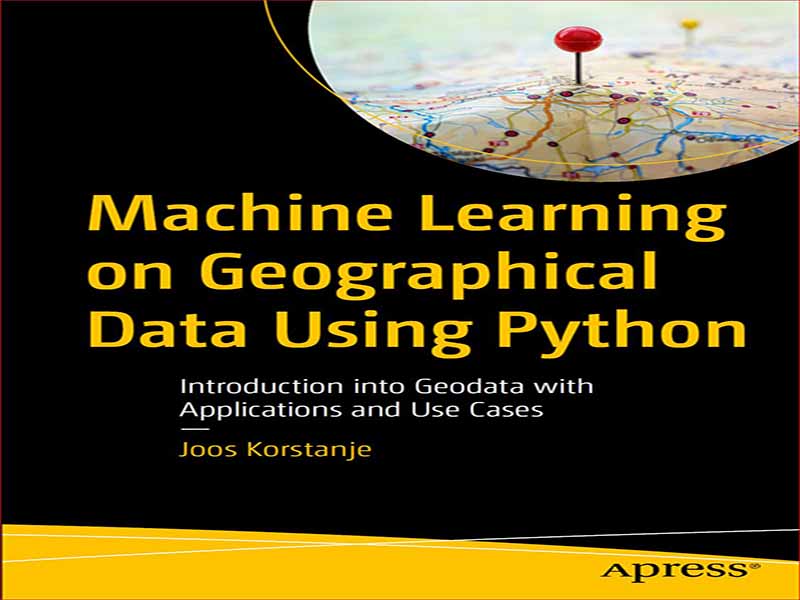- عنوان: Machine Learning on Geographical Data Using Python /Introduction into Geodata with Applications and Use Cases
- نویسنده: Joos Korstanje
- حوزه: پایتون, یادگیری ماشین, دادههای مکانی
- سال انتشار: 2022
- تعداد صفحه: 314
- زبان اصلی انگلیسی
- نوع فایل: pdf
- حجم فایل: 18.19 مگابایت
دادههای مکانی مدتهاست که یک نوع داده نادیده گرفته شده در دورههای علوم داده و آمار عمومی بوده است. با این حال، در همان زمان، زمینه ای از تجزیه و تحلیل فضایی وجود دارد که به شدت توسعه یافته است. به دلیل تفاوت در ابزارها و رویکردها، این دو زمینه مدت هاست که در محیط های جداگانه توسعه یافته اند.
با محبوبیت داده ها در بسیاری از محیط های تجاری، اهمیت پردازش داده های مکانی نیز افزایش می یابد. هدف کتاب حاضر این است که با پوشش ابزارهای هر دو جهان و نشان دادن نحوه استفاده از ابزارهای هر دو برای پاسخ به موارد استفاده، شکاف بین علم داده و تحلیل فضایی را پر کند.
کتاب با مقدمه ای کلی بر داده های جغرافیایی، از جمله فرمت های ذخیره سازی داده ها، انواع داده ها، ابزارها و کتابخانه های رایج در پایتون و موارد مشابه آغاز می شود. توجه زیادی به ویژگی های داده های مکانی، از جمله سیستم های مختصات و غیره می شود.
بخش دوم کتاب تعدادی از روشهای حوزه تحلیل فضایی را پوشش میدهد. همه اینها در پایتون انجام می شود. اگرچه پایتون رایجترین ابزار در تحلیل فضایی نیست، اما اکوسیستم گامهای بزرگی در جهت کاربرپسندی برداشته است و قابلیت همکاری بسیار خوبی با کتابخانههای یادگیری ماشین دارد. پایتون با اکوسیستم غنی از کتابخانه ها ابزار مهمی برای تحلیل فضایی در آینده نزدیک خواهد بود.
بخش سوم کتاب چندین مورد استفاده از یادگیری ماشین را در دادههای مکانی پوشش میدهد. در این بخش از کتاب، می بینید که ابزارهای تحلیل فضایی با ابزارهایی از یادگیری ماشین و علم داده ترکیب می شوند تا موارد استفاده پیشرفته تر از آنچه در بسیاری از ابزارهای تحلیل فضایی ممکن است، تحقق یابد. به دلیل ماهیت خاص مختصات و سایر قالبهای داده خاص دادههای مکانی، ملاحظات خاصی برای استفاده از یادگیری ماشین در دادههای مکانی مورد نیاز است.
Spatial data has long been an ignored data type in general data science and statistics courses. Yet at the same time, there is a field of spatial analysis which is strongly developed. Due to differences in tools and approaches, the two fields have long developed in separate environments.
With the popularity of data in many business environments, the importance of treating spatial data is also increasing. The goal of the current book is to bridge the gap between data science and spatial analysis by covering tools of both worlds and showing how to use tools from both to answer use cases.
The book starts with a general introduction to geographical data, including data storage formats, data types, common tools and libraries in Python, and the like. Strong attention is paid to the specificities of spatial data, including coordinate systems and more.
The second part of the book covers a number of methods of the field of spatial analysis. All of this is done in Python. Even though Python is not the most common tool in spatial analysis, the ecosystem has taken large steps in user-friendliness and has great interoperability with machine learning libraries. Python with its rich ecosystem of libraries will be an important tool for spatial analysis in the near future.
The third part of the book covers multiple machine learning use cases on spatial data. In this part of the book, you see that tools from spatial analysis are combined with tools from machine learning and data science to realize more advanced use cases than would be possible in many spatial analysis tools. Specific considerations are needed for applying machine learning to spatial data, due to the specific nature of coordinates and other specific data formats of spatial data.
این کتاب را میتوانید بصورت رایگان از لینک زیر دانلود نمایید.
Download: Machine Learning on Geographical Data Using Python




































نظرات کاربران